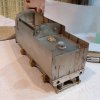oldravendale
Western Thunderer
Excellent suggestions for dealing with my (minor) issue, chaps. Thanks so much. I've used those foam stick files previously, Simon, to good effect but they tend to relieve sharp edges so am selective where they are appropriate. I too have several sets, the oldest of which are just right for the final polish sequence. And board nail files are all good, Steph - used them too - but they are quite coarse and can scratch such that polishing out can be difficult. I prefer the emery on board approach.
And yes, I am missing the challenge Peter. In the sense of not missing it at all!! I've not tried twisting the tabs off, though, as I've been cautious about the possibility of damaging/bending one of the components.
The price of those flexible boards from Cookson Gold is not bad, Mick. Thanks for the advice. They are one of my preferred suppliers but I had no knowledge that they can supply these boards. I'll add some to the next order.
Brian
And yes, I am missing the challenge Peter. In the sense of not missing it at all!! I've not tried twisting the tabs off, though, as I've been cautious about the possibility of damaging/bending one of the components.
The price of those flexible boards from Cookson Gold is not bad, Mick. Thanks for the advice. They are one of my preferred suppliers but I had no knowledge that they can supply these boards. I'll add some to the next order.
Brian







 .
.













